This is another one of those end-of-year blog posts. As I reflect back on 2018 though, it certainly has been an extraordinary year.
I wrote this a few days ago and have been hesitant to post it. If anyone who reads this is interested in traveling to Nepal, I don’t want to discourage that. Nepal is one of the poorest countries in Asia, and is populated by fascinating, diverse, kind, and beautiful people, many of whom desperately depend on tourism for their livelihood. If you’re interested, I encourage you to go! However, I feel like I have an obligation to tell my story. Perhaps it will help would-be travelers to go with more realistic expectations than I had, and to be more fully prepared than I was for the challenges they may face.
The Truth About Nepal
On September 4, the New York Times published an exposé titled Near Everest’s Slopes, a Helicopter Rescue Fraud Preys on Trekkers. The article described rampant fraud in Nepal involving trekking guides, helicopter rescue services, and hospitals. I’m not surprised by this news, as I experienced hints of it myself while traveling in Nepal this year. However, my experience differed from those of others whose stories were featured in the article.
I was there in April, hiking among the world’s tallest mountains. I was traveling solo on a 19-day adventure with Himalayan Glacier. Ultimately the goal was to climb Imja Tse (Island Peak), a glacier climb to 20,305 feet and a full-on view of the massive southern wall of Lhotse. When I arrived at Himalayan Glacier’s office in Kathmandu, I was introduced to Bob and Beth, two other Americans who were also traveling solo with the same guide service, and with itineraries similar to mine. We each had our own guide and porter, and would travel separately, though we would frequently encounter each other on the trail. Ultimately Bob and I were to meet up at Island Peak base camp and climb Island Peak together.
Although you might think otherwise as you read the rest of this blog post, my experience in Nepal was largely positive. Step by step I absorbed the amazing beauty of the Khumbu Valley, surrounded by towering white peaks — Kusum Khangkaru, Kongde, Thamserku, Kangtega, Ama Dablam, Nuptse. We strolled through quaint mountain villages where children ran up to greet my ever-smiling Sherpa guide with a hardy hug. Sherpas in general were — as expected — always laughing and smiling and seemed to be enjoying their lives, despite having very little material wealth.
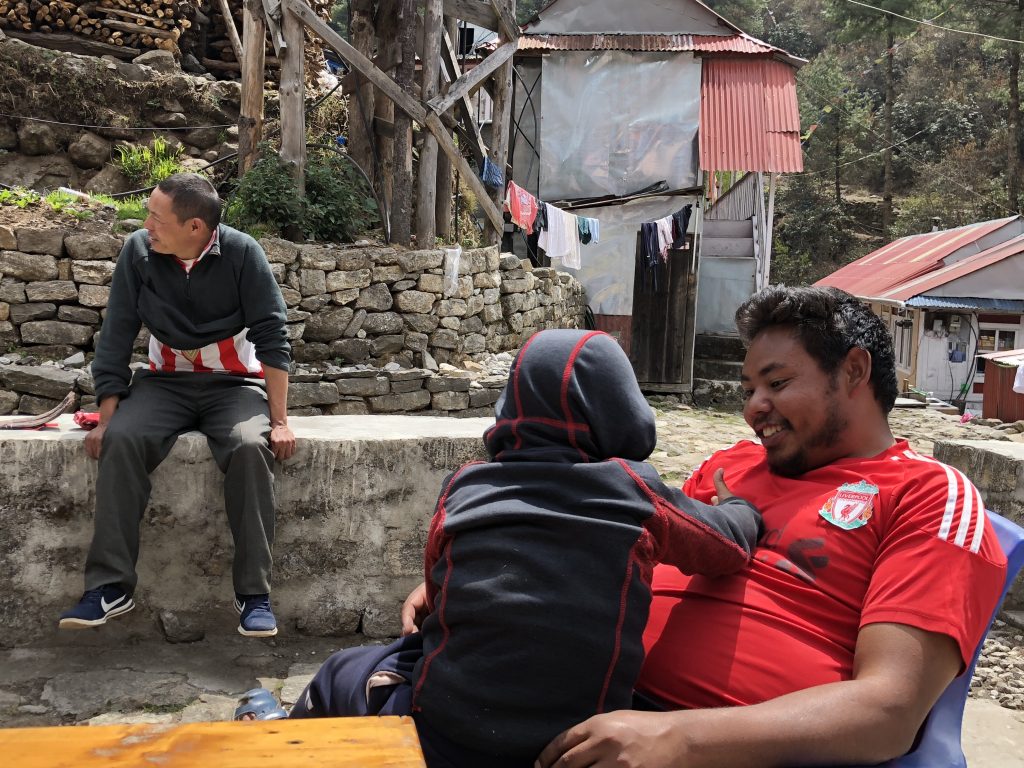
Buddhist stupas dotted the trail along the route, and Tibetan prayer flags provided an omnipresent rainbow of color, ever-flapping in the Himalayan breeze. My trek to Everest Base Camp was everything I had imagined.
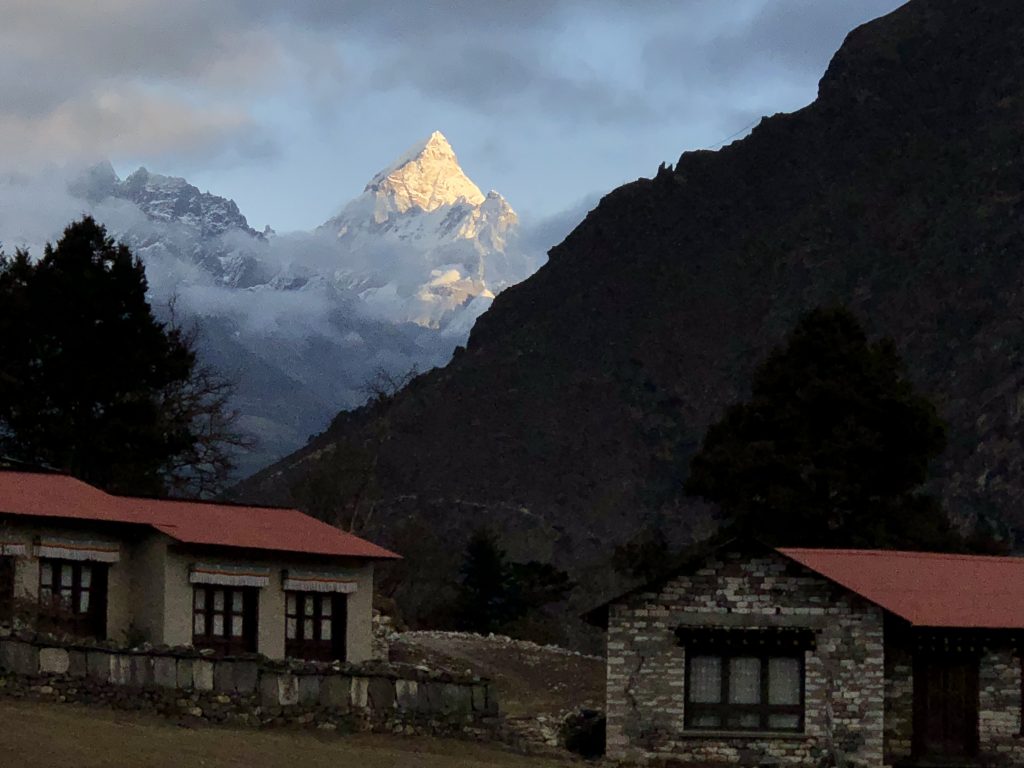
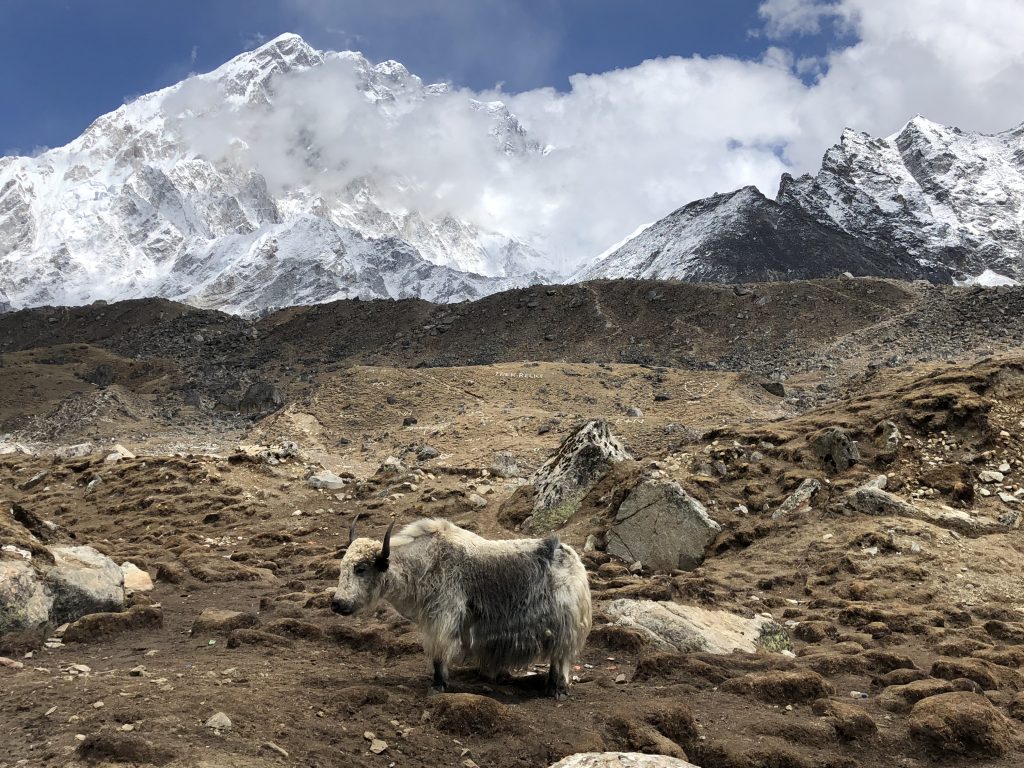
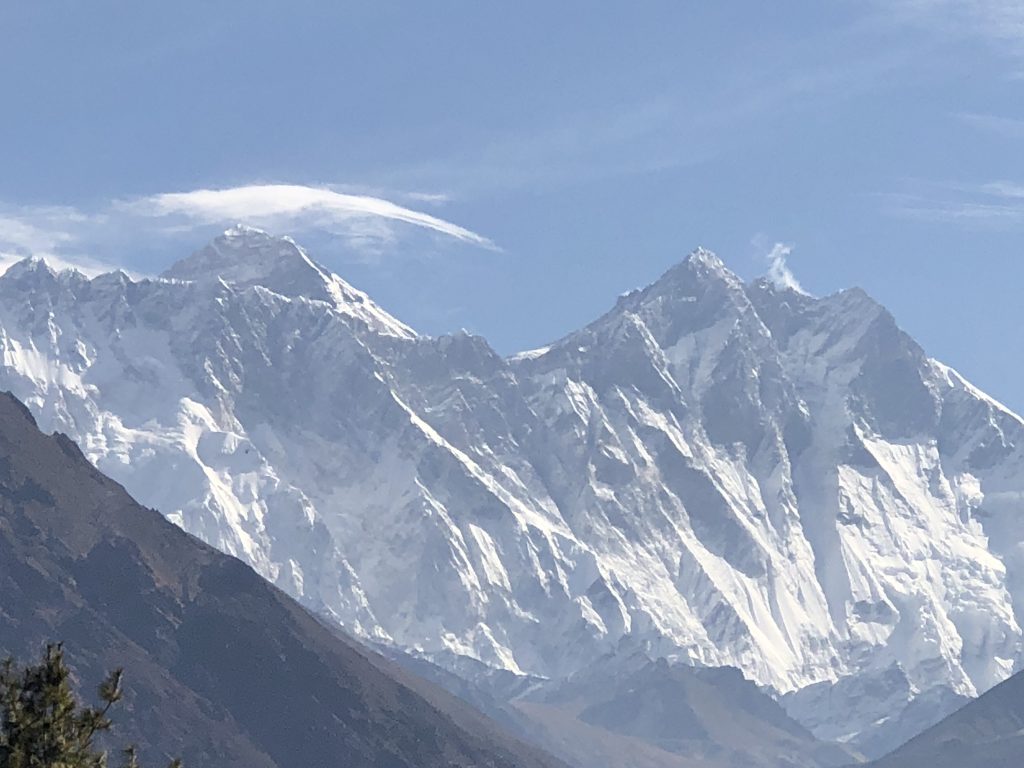
I was taking 125MG of Diamox twice a day to prevent altitude sickness, plus ascending slowly, covering about 2000 feet of elevation gain per day on average. Either or both of these strategies were effective, as I felt great all the way to Base Camp at 17,598 feet. Diamox occasionally caused a tingling sensation in my fingertips, which was a bit maddening but better than altitude sickness, and this side effect was intermittent and usually brief.
The altitude was clearly affecting many of my fellow trekkers, as it became common to see people in the villages, slumped over their tables at outdoor cafes, too sick or uncomfortable to hold their heads upright.
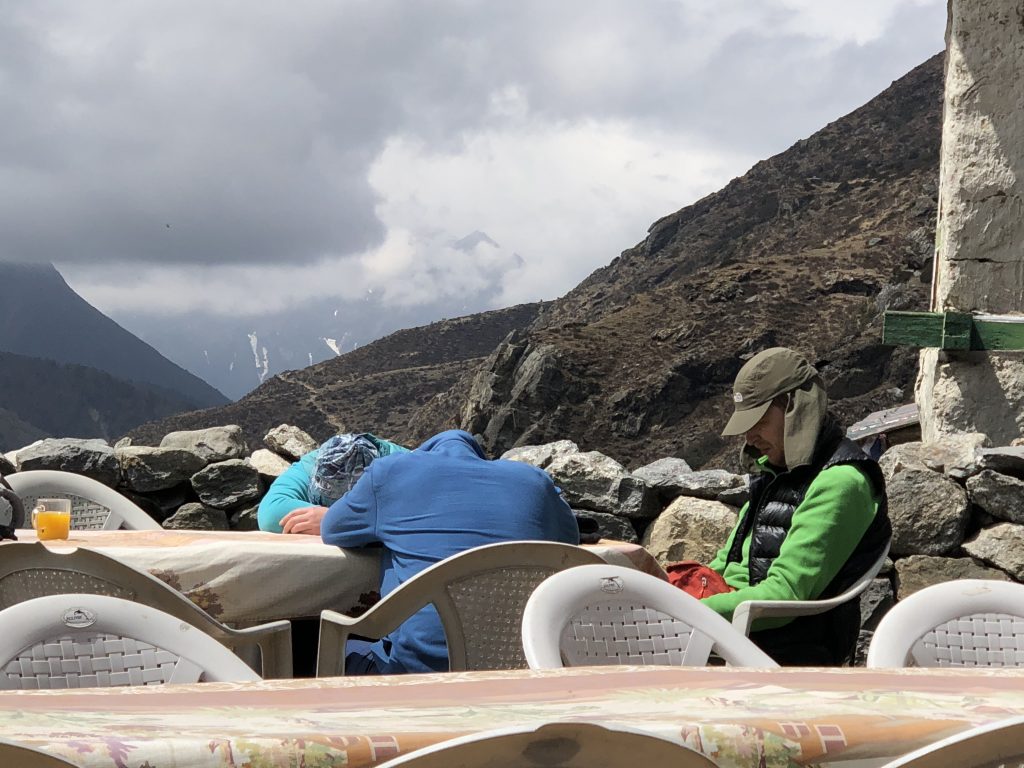
The sound of the Himalayas consists of bells from the many yak trains that share the trail, and laughter of Sherpas as they warmly greet each other in passing. But these sounds are often drowned out by the motorized buzz of helicopters, as the emergency evacuation crews zip back and forth between the upper villages and Lukla or Kathmandu, shuttling sick trekkers and climbers down to lower elevations. The higher I got, the more frequently I encountered suffering people. In the coffee houses, nearly all the parties I met had evacuated at least one of their members. In the inns, thin walls separated me from sick people who were moaning or vomiting. In several instances I saw people so sick they could barely muster the strength to move. One after another, the helicopters arrived in these villages, loaded sick people, and shuttled them off to lower elevations.
Sickness is contagious. The more I was surrounded by it, the more I began to feel it — headache, nausea, fatigue. I dismissed this, believing I was just reacting psychologically to the sickness that surrounded me, and I was able to continue my trek toward Everest Base Camp, and finally arrived on the seventh day. Being there, the place I had read so much about all my life, with dozens of teams busily setting up climber camps at the foot of the Khumbu Ice Fall and preparing for a season of climbing on the world’s tallest mountain, gave me renewed energy. I felt great, despite being 3,000 feet higher than I had ever been, and much higher than I had ever been for sustained periods.
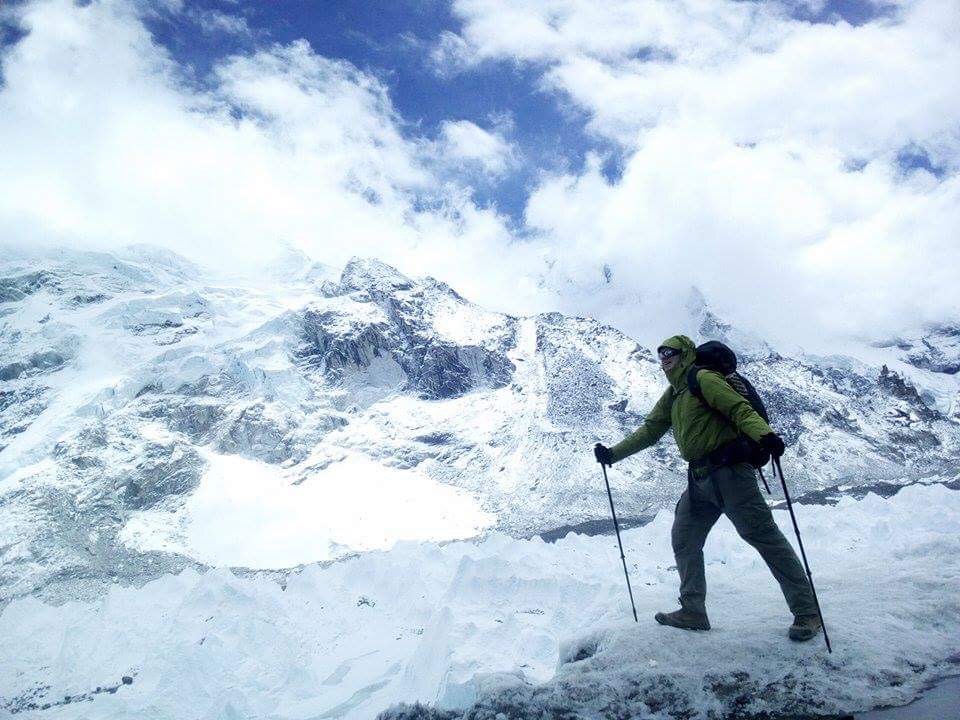
After spending some time at Base Camp we descended back to the nearest village, Gorak Shep (16,942 feet). That night my health took a dive. I was unable to breathe. Each breath left me unsatisfied, and I had to follow that immediately with a second breath, deeper than the first. I started to feel like I was drowning, and began to panic. I developed a splitting headache and grew increasingly nauseous. I didn’t sleep at all that night, and couldn’t wait for morning to arrive. When it did, I slowly, sheepishly made my way downstairs to the attached tea house. The Sherpas were already up and about, including my own guide, and they stared at me with concern. I could tell by their expressions: They knew. Another trekker was about to bonk.
Was this altitude sickness? It seems odd that Diamox and gradual ascension would work fine up to this point, then suddenly fail. In retrospect, I wonder whether it might have been something else: Sanitation in Gorak Shep was terrible. By U.S. standards, it was bad everywhere along the trek, but this was the worst I had experienced. The one shared toilet in the inn was clogged and overflowing with others’ diarrhea, and any effort to get it to flush (by dumping water from a nearby barrel using a large tin coffee can that everyone shared) just exacerbated the problem. Also, my room at the inn smelled of gas, like I was sleeping directly above a leaky pipe. Maybe all of my symptoms were due to this toxic environment.
I tried drinking coffee and eating a little something — I don’t remember what — but I remember it didn’t settle. All the symptoms I had experienced overnight were still with me, and were worsening. I laid my head on the table, totally relating now with the people I had seen in this position at the outdoor cafes. I wrestled silently with the decision that faced me: Do I continue on? Today’s plan was to climb Kala Patthar (18,519 feet) for a full-on view of Mount Everest, then return to this same awful inn for another night before venturing on to Island Peak Base Camp (another 2-3 days trek), where Bob would be waiting and eager to climb.
None of this sounded at all possible given my current state. Conveniently (perhaps too conveniently?) I had evacuation insurance. The guide service required it, and advised me to make certain I was covered to the maximum elevation of my program, as many insurance policies have elevation limits. Before leaving the U.S., I had contacted my primary medical provider, Kaiser Permanente, to find out whether my policy would cover emergency evacuation from 20,000 feet. They couldn’t tell me. They said I would have to file a claim and find out after-the-fact whether I was covered. This was my first clue that Kaiser Permanente sucks, but it certainly wasn’t the last.
Given my uncertain coverage under Kaiser, I had purchased supplemental insurance from Good Neighbor Insurance, designed specifically for adventure travelers like me, and they confirmed in writing that their plan would cover me at my target elevation.
My supplemental coverage had a mere $150 deductible, which in my current state seemed like a highly affordable price for a once-in-a-lifetime helitour of the high Himalaya, which in a few minutes would bring me to a lower elevation and — hopefully — immediate relief from my suffering.
This is where my story deviates most from those of others featured in the New York Times article. In their stories, the guides were part of the conspiracy, encouraging people to evacuate unnecessarily in order to get a kickback from the helicopter pilots and/or hospitals. In my story, my guide actually discouraged me from being evacuated. He thought we should stick with the program. He thought I would feel better with some fresh air and exertion if we climbed that day to Kala Patthar as planned.
In retrospect, I wonder if I should have listened to my guide. If my sickness was a response to the toxic environment at the inn, I might indeed recover quickly and be able to continue on. But if this was altitude sickness, I was acutely aware of how dangerous that can be if unaddressed (in fact, as I’m writing this I just learned that a well-respected and highly-experienced fellow member of the Mountaineers died recently of high-altitude pulmonary edema on Ama Dablam, not far from my location at that time). All I knew for sure is that I was sick as hell, and I couldn’t summon the energy to carry on. So my guide ultimately concurred, and arranged for my evacuation.
There were several of us standing on the Gorak Shep helipad that morning, too sick to commiserate. Helicopters came and went. Each time I thought it was my turn, other sick parties would climb in ahead of me and their helicopter would lift off, blasting all of us bystanders with cold wind and snow, then buzz downslope along the Khumbu Glacier. As each helicopter disappeared, the fading drone of its engine would soon be replaced by the sound of an incoming helicopter, renewing my hope.
Eventually it was my turn, and I climbed in as my guide, porter, and pilot loaded our gear. Then they all climbed in and seconds later we had taken off and were on our way to lower ground. The flight was amazing. Despite being ill, I was overflowing with gratitude for the opportunity to experience the high Himalaya from this close-up arial perspective.
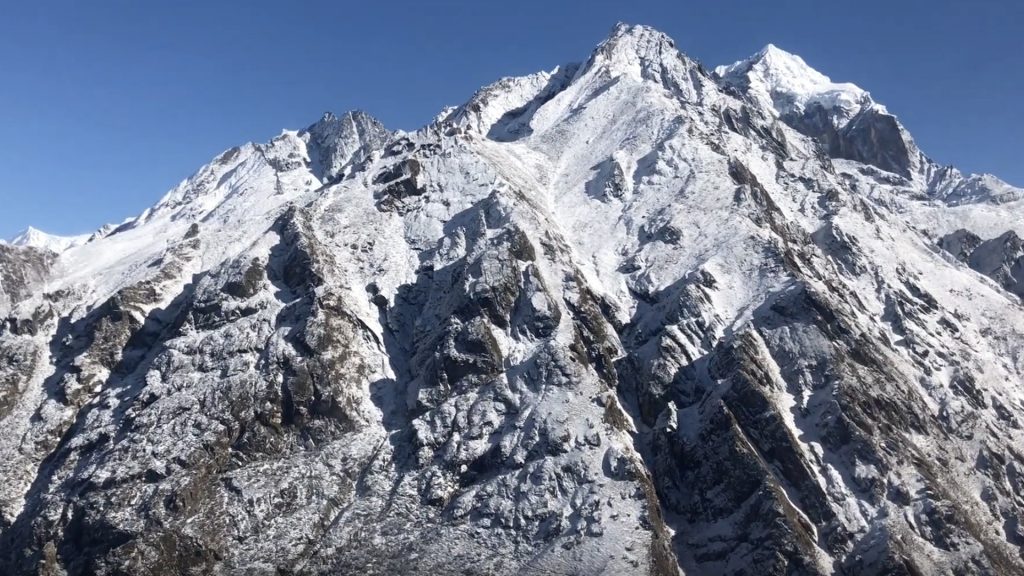
We landed in Lukla and switched to another helicopter for the final flight to Kathmandu. Even at Lukla’s elevation (9,380 feet), I felt much better, which would seem to indicate that I had indeed been suffering from altitude sickness (although not necessarily, since I had also escaped the toxic inn environment). When we landed in Kathmandu (4,600 feet), I felt great! It was a full and immediate recovery. My guide had warned me though that I would need to go to the hospital so a doctor could certify my need for evacuation. This was a technicality required by insurance companies. This made sense, but I wasn’t prepared for the extent of this technicality.
Prisoner
As I climbed out of the helicopter at Kathmandu International Airport, an ambulance came speeding across the tarmac in my direction. Before I could fully appreciate what was happening, a crew had loaded me onto a stretcher in the back of the ambulance and was speeding away. The siren wailed, the horn grunted, and the ambulance made its way through Kathmandu, where drivers yield for no one and utilize every inch of drivable space, both street and sidewalk.
We arrived at Norvic International Hospital, where I was promptly greeted by a doctor in blue scrubs, who explained in perfect kindness and very good English, that cases like these may seem to be cut and dry: Go high, develop symptoms; go low, relieve the symptoms. But they like to know for certain, which therefore requires observing all possibilities. So they drew blood, took x-rays, conducted an EKG, took urine and stool samples, and conducted analyses of all these tests using various methods. I was told they would need to admit me as an inpatient, as it would take some time to analyze all the tests. I protested, pleading perfect health, but the doctor offered a warm smile and assured me “It’s just a precaution. We want to be sure you’re healthy.”
After my initial welcome, I had an oxygen tube inserted into both nostrils and an IV slowly dripping fluids into a vein in my right hand. My efforts to decline these treatments had been rebutted, and each time they insisted until I ultimately gave in and accepted. I wondered whether they administered this much care to all their patients, or if I was being singled out as an American.
A few hours later, in my dimly lit private room, I was listening to the gentle trickle of my IV and the soft hum of medical equipment mounted behind me. Outside I could hear the muffled thunder from an afternoon thunderstorm. The bed was too short for someone as tall as I, but I could sort of fit diagonally. Overall this was much more comfortable than the cold, cramped, thin-walled bedrooms I had occupied over previous nights in the Everest region. Here, the lights not only worked but had multiple configurations, adjustable via remote control (which I could also use to adjust the air conditioning). The toilet flushed normally, everything was freshly mopped, the food menu was extensive and presumably could be trusted to be sanitary, and the cheerful nurses returned frequently to tend to my needs. These were pretty posh accommodations for Kathmandu, but I was starting to worry about whether insurance would cover it all. It seemed so unnecessary.
Early the next morning, my doctor returned, this time accompanied by a new doctor who appeared to be of higher authority. Unlike the first doctor, the new doctor was wearing a suit and tie, and when he spoke, everyone — including the first doctor — listened with utmost attention. The new doctor, in a voice that was both commanding and kind, welcomed me to Kathmandu. He explained that my test results were back, and everything looked good except my “cumin” levels. I asked for clarification, and he once again said something that sounded like “cumin”, and explained that low cumin is associated with dehydration. So they would continue to monitor my cumin levels while keeping me on the IV, and would expect to see an improvement. I considered responding with a smart-ass American remark like “How are my saffron levels?” but refrained. I also considered ordering a curry from the room service menu and to request extra cumin, just too see if that would hasten my recovery. The doctor concluded his visit by saying they would need to keep me for a second night. “What?!” I vehemently protested, but he said “It’s just a precaution. We want to be sure you’re healthy.”
The second day of my hospitalization was April 14, 2018, Nepali New Year. On learning this, I was both angry and sad to be spending the holiday in a hospital bed rather than celebrating with the locals. The window of my room was open and outside I could hear monks chanting, presumably offering their prayers for the benefit of sick and dying people, like myself. I was comforted by their presence.
My guide kindly stopped by and spent much of the afternoon sitting by my bedside.
“It’s Nepali New Year,” I said. “Don’t you have something else to do?”
He thought for a moment, then shook his head. “No.”
But after days trekking together, we had little left to talk about. I appreciated his kindness but really just wanted to be alone. Eventually I gave him a handful of Nepalese rupees and asked him to go, and to give the money to the monks on his way out and thank them for their chanting. He smiled and agreed to do so.
My IV frequently stopped dripping, and I feared this complication would result in their wanting to keep me even longer. Whenever I brought this to attention of the nurses, they would inspect the hoses and struggle — always unsuccessfully at first — to get the system working again. Ultimately they would always say “I think we need flush”. These words, which I probably heard fifty times over three days, became my trigger words. They meant the torture was about to resume again. They would temporarily pinch the IV hose to stop all fluid flow, then suddenly release it so the built-up pressure would return the system to a normal flow. This resulted in a shot of pressure flooding into my vein, which hurt like hell and I believed was probably a bad medical practice. I wondered if they had learned these techniques in nursing school or had figured them out informally — helpful tips and tricks exchanged between nurses — with no knowledge or concern that they might be subjecting their patients to irreparable long-term harm.
“Don’t do that!” I would say, and they would laugh and say “sorry”.
They often accompanied this procedure by rubbing and thumping on my vein at the point of insertion, which also hurt like hell.
I was a tortured prisoner, and I became increasingly paranoid that I was being held either for profit or some political purpose. I imagined how I might escape: an overturned cart, shattered glass instruments, me sprinting through the alleys of Kathmandu, upsetting stands of Buddhist paraphernalia and fresh fruit, the well-dressed doctor in relentless pursuit shouting “After him!” I expressed my concerns to my wife Nina over Facebook Messenger and she provided me with the phone number of the U.S. Embassy in Kathmandu. I was ready to use that if they tried to keep me for a third night.
During my second night of captivity, I slept very little. I kept my iPhone charged and listened to all three Bon Iver albums, then listened to the beautifully depressing album Cut the World by Antony and the Johnsons. I practiced writing the English alphabet with my non-dominant left hand, since my right hand was attached to the IV and unavailable.
I was still practicing the alphabet when morning arrived and a crowd of cheerful nurses entered my room to offer kind greetings and to take my vitals. I gathered them around and on the same sheet of paper I had been using to practice my ABCs, I sketched a line graph illustrating what I called The Hospital Effect.
The solid line represents the typical patient, I explained, and a dashed line represents me. The X axis represents time and the Y axis represents wellness. The typical patient enters the hospital at a relatively low point on the Y axis (not well), and their wellness gradually improves over time. However, after a point the trend begins to reverse, an indication that the patient has been too long in the hospital. My dashed line was essentially the same as the solid typical patient line, except that I was already well when I entered the hospital (high on the Y axis). I might have gotten a little healthier during my two days there, but by now I had surpassed the point of continuing improvement and was on the downward slope.
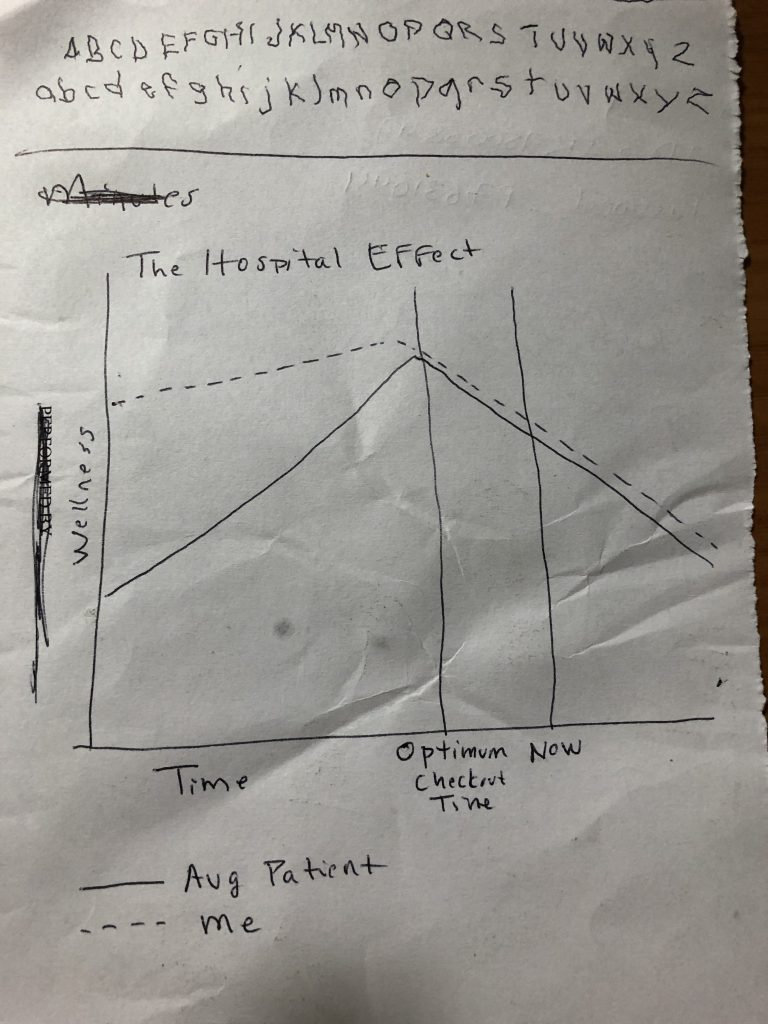
My nurses were troubled by this, and felt that if my wellness was declining, they were directly responsible and would need to try harder. Their reaction concerned me. Maybe I had said too much. My attempt to educate might be used against me as evidence that I wasn’t fully recovered and needed to stay longer in the hospital.
I tucked my sketch away, and waited for a visit from the head doctor. He finally arrived late that morning, and I greeted him enthusiastically and declared that I was in perfect health and ready to leave. I waited with bated breath as he consulted my charts, and ultimately he smiled and said, “Looks good. You can be released as soon as we prepare the bill.” My right hand was still attached to the IV, so I extended my left hand to the doctor for a handshake. He seemed surprised and paused briefly before accepting, and the nurses all seemed to gasp. He ultimately accepted my handshake with a firm grip, through I realized then that I had offered him my unclean hand, a cultural taboo. It was probably especially disrespectful to put a man of his stature in that position, in front of all his nurses nonetheless.
My release from captivity did not go smoothly. The ladies at the front desk claimed they had attempted to submit my bill to my medical insurance provider, but had not received a response. I blamed them and doubted they had even tried. If there had been problems reaching Kaiser, surely these could have been resolved after three days. My later interactions with Kaiser have led me to reassess my initial blame. It now seems totally feasible that Kaiser would be unresponsive.
I asked to speak with a higher authority, but this interaction didn’t help. I was going to have to pay my hospital bill out of pocket, and they weren’t going to let me leave without doing so. Who’s going to stop me?, I thought. Once again I imagined a scene in which I’m running through the streets of Kathmandu, the doctor, nurses, and hospital staff in hot pursuit.
“I don’t have enough money,” I pleaded.
“Then we must take your passport. We’ll return it after you pay.”
So I paid the bill with my credit card. Surprisingly it wasn’t much given the extent of the services I had received over three days and two nights: Just over $2000 U.S. Most importantly, I was free, and relieved to have that all behind me.
Nepal’s Helicopter Mafia
I checked into a hotel in the Thamel district of Kathmandu and set out to explore the city. I successfully changed my flight to an earlier date, but still had a few days before I could depart. So I roamed the streets of Kathmandu, visiting vendors who showed me their vast varieties of Buddhas, Tibetan singing bowls, and brightly colored hand-woven cashmere shawls and scarves. A canopy of prayer flags criss-crossed the streets and painted the scene with primary colors. The air was thick and fragrant with a mix of incense and gasoline. Motorcycles, taxis, and rickshaws battled pedestrians for street and sidewalk space, and the sounds of horns honking and people shouting echoed through the alleys. I wanted to browse the vendors’ products that were on display as I strolled casually along, but I found that I had to remain ever-vigilant or I would get run over.
After half a day of Kathmandu’s cacophony, I was exhausted from the sensory overload and returned to my hotel for an afternoon nap. Not long after dozing off, I was awakened by a knock at the door. I couldn’t imagine who would be knocking, but perhaps naively I felt no fear, just curiosity. So I rose from the bed and opened the door, and was surprised to find two strange men in my doorway. One was tall and thin, the other short and stocky. Both were wearing black leather jackets and pants, and the tall one was wearing silver reptile-skin boots.
“May I help you?” I asked.
“We’re here for the helicopter company,” the tall one said. “You owe us $5000 U.S.”
“What? I have insurance for that.”
“We know nothing about insurance. All we know is that you owe us $5000 and we’re here to collect.”
“I don’t have $5000!”
I tried to convince them that there was some mistake, but they didn’t buy it. I tried to convince them that some Americans are poor and don’t just walk around with $5000 in their pockets, but they didn’t care. I found myself wondering about gun control in Nepal. Might these guys be packing? I believed that guns were tightly controlled among the Nepali citizenry, but even if that were true, might these guys be exempt or able to obtain guns illegally? Even without guns, these guys were probably capable of making me disappear. So I didn’t want to push them too far, but I pleaded for them to give me some time to try to contact my insurance company in the United States. They finally agreed, but said they would be back in 24 hours, and I’d better have the money.
Kathmandu is approximately 12 hours and 45 minutes ahead of Phoenix, where Good Neighbor Insurance is located (curiously, Nepal is one of only two places on Earth that defines time zones in quarter hourly increments). Despite the time change, I was eventually able to talk with a person in the United States about my predicament. There was much confusion on both sides, but ultimately I came away realizing (for the first time) that international insurance typically operates on a reimbursement basis, and that I would indeed be expected to pay out of pocket for all services, then seek reimbursement later.
The next morning, I phoned the helicopter company directly, hoping to pay with a credit card by phone and avoid any further interactions with the tough guys who had visited me the previous day. But they said they couldn’t take payment by phone, and would send their boys to collect. They were surprisingly prompt, arriving almost immediately after I hung up the phone (had they been camping outside my door?) Also surprisingly, they accepted credit card, charged me $5000, and printed me a receipt.
I later learned that both Bob and Beth had also gotten sick, and had also been evacuated. Beth, like me, had spent time in the hospital, but Bob is medically trained and had been more assertive in refusing treatment. Bob later asked “Did you get a visit from those two guys?” Apparently this was a common experience.
I spent my remaining days in Nepal visiting temples and hoping to capture a sense of the peace and beauty that had always been at the heart of my vision of Nepal. But that’s another story…
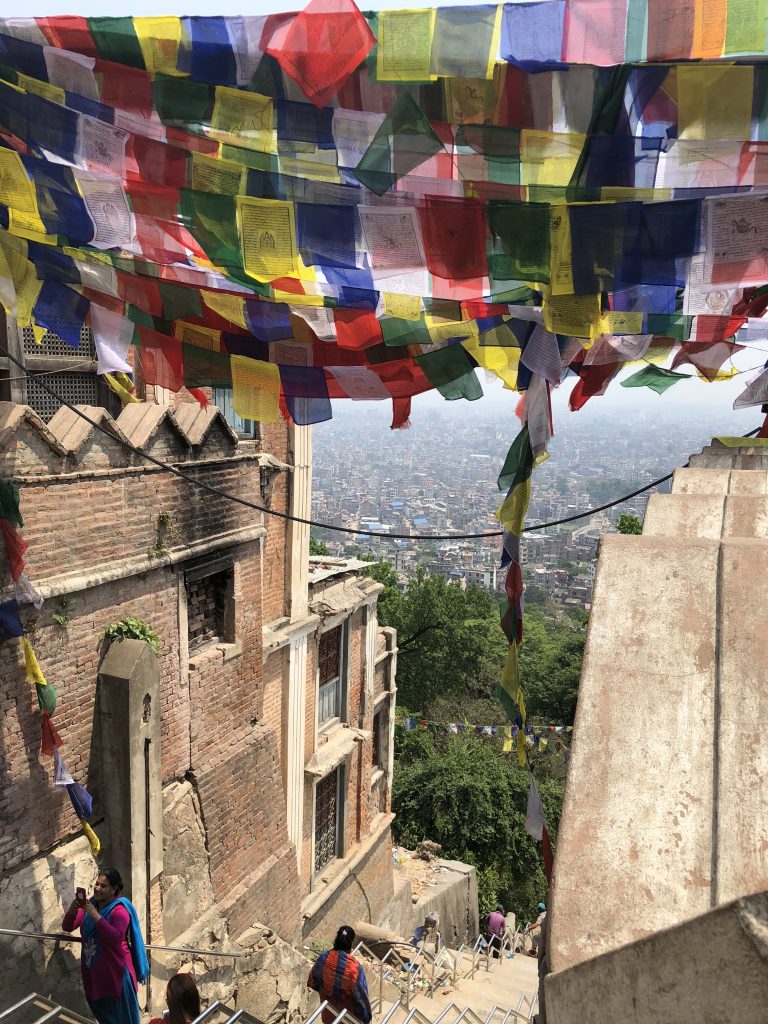
Why Kaiser Permanente Sucks
Soon after returning to the United States, I began the process of collecting my reimbursement for out-of-pocket emergency medical expenses.
On April 23, I submitted one claim to Kaiser for my hospital bill, and another claim to Global Underwriters for the helicopter bill. Global Underwriters was the provider of the insurance policy that I had purchased through Good Neighbor.
I didn’t submit the helicopter bill to Kaiser because that’s precisely the type of thing I had purchased the secondary insurance for, and I knew from my previous exchange with Kaiser that they didn’t know whether they covered it. So I figured I would assume they did not, and would go straight to the secondary provider. However, I soon learned it doesn’t work that way. I received a prompt response from Global Underwriters saying they couldn’t process my claim without a written denial of coverage from Kaiser.
Meanwhile, Kaiser processed my hospital claim fairly quickly, and without incident. That was the last time I had a positive experience with them.
On July 2, I phoned Kaiser Customer Service and spoke with Joseph. I requested a letter from Kaiser simply stating that my policy doesn’t cover the helicopter evacuation service I received. He thought about this for a while, and put me hold a few times as if talking it over with others. However, he ultimately declared that they couldn’t write such a letter. I would have to file a claim, then have that claim rejected.
Filing a claim was a bit complicated since I had already filed a claim for hospitalization, and the helicopter evacuation was related to the same incident. I asked if I could file an addendum to my previous claim, rather than submit an all new claim, and Joseph said “No”.
The next day (July 3), I spent a few hours attempting to fill out the Medical Claims Form. Initially I tried doing this myself but couldn’t figure out how to best answer the questions in a way that would minimize confusion for Kaiser, given the two interrelated but not explicitly associated claims. I finally called Kaiser again and stepped item-by-item through the form with Olivia and she told me exactly how to fill it out. She assured me the two claims wouldn’t be confusing, because they would both be tied to my account so they could easily be cross-referenced. As soon as we had finished filling out the form, I drove 10.6 miles to the nearest post office and dropped it off (Kaiser only accepts claims by mail).
On July 20, after 17 days of waiting and hearing nothing from Kaiser, I decided to call and check on status. Francis seemed confused and kept putting me on hold while he searched for my claim, but ultimately he declared there was no sign of my claim in their system, and by now that probably meant it was lost and I would need to resubmit.
Since this was seemingly their fault, I asked for an exception to their “only by mail” policy. Wasn’t there some way I could submit my claim electronically this second time? But Francis said “No”.
So reluctantly, I once again made copies of all my receipts, bundled everything together, wrote a second cover letter and attached it to the first, and drove 10.6 miles to the nearest post office. This time I did what I should have done the first time: I sent it via Certified Mail so I had a tracking number and a signature confirming receipt.
Exhibit A. Let the evidence show that my second claim was picked up at the post office in Seattle on Tuesday July 24 at 12:51pm by Tony:
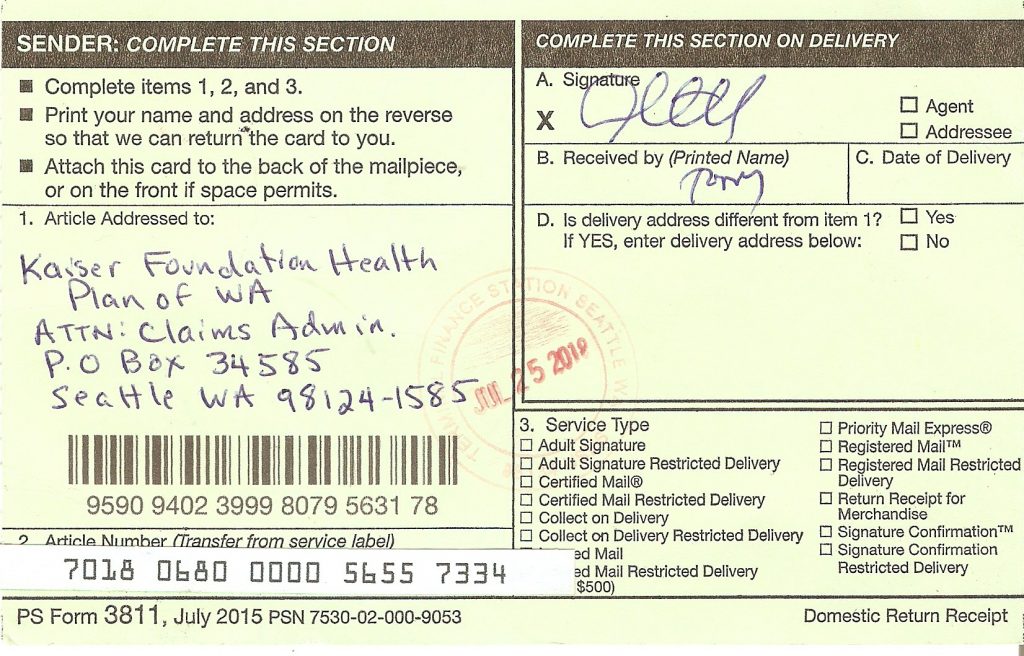
In my second cover letter, I asked Kaiser to contact me either by phone or email to confirm receipt. However, 15 days later (August 3), I still hadn’t heard anything. So I called them again to confirm receipt, and Danielle sounded every bit as confused as Francis had been. There was no record of my new claim in their system. I asked Danielle to step logically with me through troubleshooting this problem.
“We know that someone named Tony picked up my claim in the mail on Tuesday July 24 at 12:51pm. So…”
- Who is Tony?
- Which department does Tony work for?
- After Tony picks up the mail, what do they do with it?
- At what point do claims get entered into the computer?
- How many people touch the claims between the time when Tony picks them up and the time they’re entered into the computer? Assuming this is a small number of people, can we follow-up with each of those individuals to see what might have happened to my claim?
Danielle couldn’t answer all of these questions, but she was surprisingly willing to shed some light on what happens in the shadows behind Kaiser’s closed doors. She explained that the first stop after receipt of a claim is the Claims Department, and that’s who enters information about the claims into the computer. However, the Claims Department doesn’t accept phone calls so there’s no way to contact them to track down a claim, and Customer Service doesn’t have access to the records entered by the Claims Department until the claims are processed, which doesn’t happen for 30-45 days (or 60-90 days, depending on which customer service rep you’re talking to). So, throughout the entire period of 1-3 months before claims are processed, it’s impossible to simply confirm that they’ve received it.
It’s possible that Danielle was just feeding me a line of BS and didn’t really know what she was talking about. But if what she told me was true, this was totally unacceptable! I demanded to speak to Her Supervisor. I assured Danielle that I was happy with the quality of her service but not happy with Kaiser’s nonsensical workflow and lack of transparency. At this point I was so flabbergasted that I dropped the ball on noting the supervisor’s name, but I didn’t get much further with her. She sounded a bit dismissive, like she was too busy to deal with stupid customers like me and would say anything to get me off the phone, so she simply confirmed that what Danielle had told me was true. So, I reaffirmed my position that their system was severely flawed, anti-customer, and totally unacceptable, and demanded to speak with a grievances department as I wanted to file a formal complaint.
The supervisor, all-too-happy to pass me off to someone else, transferred me to Grievances, where I waited on hold for over 30 minutes, listening to soothing new age music. The longer I waited, the more I found humor in waiting. Was this Kaiser’s Grievances Department? Did they simply send angry customers into an isolation chamber where they could chill out and eventually hang up? This was so absurdly amusing that I actually was a little disappointed when someone finally picked up. I still wonder whether there’s a mandatory minimum on-hold time before Grievances will take a call.
The response I got from Celia in Grievances was beyond hysterical. She was — as one might expect for someone in Grievances — very patient, kind and understanding. However, after listening to my story she became sincerely apologetic, and informed me that I had been transferred to the wrong grievances department!
This was incredible, and Celia knew it. Despite my particular grievance not falling within her scope, she nevertheless said she would take it upon herself to help. After doing some investigating, she discovered that my claim for emergency evacuation was in fact entered into the system, but it was entered either partially or incorrectly (e.g., no date of service) which is why it wouldn’t show up when Customer Service reps were trying to find it.
She said she would ask her supervisor to reach out to a supervisor within the Claims Department and they would fix this and call me back with a status report. I concluded my conversation with Celia feeling hopeful for the first time since this fiasco had started.
But nobody ever called me back. Why not? Was Celia — this wonderful person who I had liked and trusted — simply trained to say whatever it takes to restore customers’ hope and get them to back off? Or had she actually done what she had pledged to do, and one or both of the two supervisors had blown her off?
By now, I felt utterly defeated. This feeling reminded me of being back in the hospital bed in Kathmandu, connected to an IV, waiting for a solution but having no faith that I would actually receive one. I stopped calling Kaiser. Danielle and her supervisor had both said there was no way for someone in Customer Service to verify receipt of a claim, so continuing to call them would yield no positive result until the claim was finally processed. I would just have to wait. Surely they hadn’t lost both of my claims, and one of them would eventually be processed.
While I waited though, I kept remembering that Celia had in fact found one of my lost claims, and saw that it had been entered incorrectly. Might this problem prevent any further action unless I continued to fight?
Finally, on September 17, having heard nothing further from Kaiser, I sighed and once again dialed the number for Kaiser Customer Service. This was the shortest of all my conversations with Kaiser reps. I told Shawn that I had submitted two identical claims for helicopter evacuation in Nepal and I was calling to confirm receipt of either of those claims. Shawn said there’s no record of either claim in the system, and told me I would need to resubmit my claim. I said “I am not going to resubmit my claim a third time, with no guarantee that you won’t lose it again. What’s going to happen is this: You are going to find the lost claims and process them immediately.” Then I hung up. If I had been on a rotary phone like the good old days, I would have physically slammed down the phone. Instead, I very angrily and forcefully tapped the big red “end call” icon on my iPhone with my forefinger. Then I promptly filed a complaint with the Washington State Office of the Insurance Commissioner (OIC).
Enter the OIC
By the following day, September 18, OIC had written a letter on my behalf and sent it to Kaiser, expressing my concerns. The letter clearly stated that they must “review your policy and/or claim file and respond to the issues raised in the complaint” and further stated that a response was required within 15 business days. At the end of the letter, they reinforced this deadline in bold: “We expect your answer by October 09, 2018.”
I was initially impressed with the OIC. Both the speed at which they responded, and the strength of their letter, made me feel like I had an ally. Kaiser quickly responded by assigning me a dedicated contact in Member Services, an affable chap named Thomas. Thomas and I talked by phone. He sounded sympathetic but simply echoed what previous Kaiser reps had said: There was no sign of either of my claims, and I would have to resubmit. However, unlike the others he would allow me to submit my claim by fax. I asked if it was possible to submit my claim by email since fax, though better than the postal service, was still an obsolete technology and I don’t have convenient access to a fax machine. But Thomas said “No”.
I pressed Thomas for a more satisfactory solution. “Is it possible that the claim has in fact been entered into your system, but is not showing up through normal search methods because it was not entered properly? I ask that because on August 3, Celia in Grievances did say that she found my claim for emergency evacuation. She said it had been entered, but not fully entered. I think she said it was entered without a date of service.”
“Hmmm, well that’s news to me,” Thomas replied. “I was just told to have you fax your claim, so I’m assuming if a claim has been entered there’s something wrong with it, or some reason why you need to resend it.”
“Think through this with me Thomas,” I said. “We know that I sent the claim twice, and we know that you received it at least the second time since I sent it certified mail. Someone named Tony picked it up on July 24 at 12:51pm. What does Tony do with the mail after he picks it up?”
Thomas said “I don’t know anything about that. But you can fax me your claim. Here’s the fax number…”
So on September 28, I reluctantly drove 10.2 miles to the nearest fax machine and resubmitted my claim for a third time with a new cover letter plus copies of the first and second cover letters, this time by fax. Thomas phoned immediately and confirmed receipt and said he would submit it for processing. He said it would be “moved to the front of the line”. But then the silence returned. Since this was now, as Thomas had said, an expedited claim, I expected a quick response. But after waiting several days, I had heard nothing further from Kaiser.
On October 10, still hearing nothing, I phoned Thomas. He wasn’t available, but I left a message and he phoned me back. He said he had submitted my claim for processing, but after that he was unable to track its status until processing was complete. My frustration returned. This lack of communication within Kaiser was the heart of my OIC complaint! I was now back to having little or no hope that my claim would ever be processed.
Also, Kaiser was now one day past deadline on responding formally to the OIC. I contacted OIC, and in fact Kaiser had just responded (not surprisingly, they waited until the last allowable moment). Their response soon showed up in my OIC inbox. The letter they submitted to OIC was addressed to me, “Mr. Thompson”, but bizarrely, it also referred to me throughout as “Mr. Thompson”, speaking to Me about Me in the third person as if I wasn’t in the room (e.g., “Mr. Thompson, we understand that Mr. Thompson alleges he submitted a new reimbursement request by mail.”) The letter merely echoed the details I had provided in my complaint. The only additional information was that they acknowledged they had received my claim via fax, and added that “Claims processing can take up to six weeks from the date of receipt.”
There was no acknowledgment in their letter that they had lost my earlier claims, and nothing to suggest they were searching for my earlier claims, or following up on Celia’s lead, or doing anything at all to investigate the cause of the problem or to ensure this sort of thing didn’t happen again.
Shortly after receiving Kaiser’s response, the OIC sent me a message stating that they had completed a review of my complaint and uploaded a Case Review Summary to my account. The Case Review Summary was an incredible disappointment. The OIC simply repeated what Kaiser had said in their letter. “Kaiser says…” blah blah blah. “Kaiser reports…” blah blah blah. “Kaiser advises it may take up to six weeks to complete processing.”
So that was it. My case with OIC had been successfully resolved… NOT! Now I was mad as hell. And while all this was happening to me, Brett Kavanaugh was testifying before the Senate Judiciary Committee. He said he didn’t do it. So Republicans on the committee said “He says he didn’t do it” and assumed the case was closed. Mark Judge, Kavanugh’s drinking buddy and author of “Wasted: Tales of a Gen X Drunk”, was allegedly there with Kavanaugh, a co-assailant and key eyewitness, but Republicans were hell-bent on preventing him from testifying. They were also hell-bent on not allowing the FBI to investigate. With mounting pressure, they ultimately did allow an FBI investigation, but it was a half-assed investigation. Is there no justice? Does The Truth have no value in our society?
I feel a little guilty ranting about my own situation, when there are so many much greater injustices plaguing our country and world. But the problems I was facing seemed similar, particularly the lack of interest in knowing The Truth, the unwillingness to investigate. Potentially, these were signs not merely of incompetence, but of a deeper corruption. If it’s not in Kaiser’s financial best interest to pay out claims, then why should they pay them? Is there any requirement that they do so? And is there any oversight or enforcement of that requirement? Might they systematically “lose” claims until customers give up fighting in frustration and write off their losses? There were many moments throughout this fiasco when I was very close to doing that myself.
I summarized my disappointment and frustration in a letter to the OIC:
As you know, Kaiser allowed me to submit a third claim by fax, and they acknowledge having received that third claim on September 28, 2018. However, in their reply they failed to address that they had lost my two prior claims, or offer any assurances that they are investigating this matter. What happened to my second claim after Tony picked it up at the post office in Seattle on July 24? They surely are able to determine whether they have an employee named Tony who retrieves the mail. If so, then is it unreasonable to ask them to retrace Tony’s steps? What happens next in the process? At what point do claims get entered into the computer? How many employees touch the claim before that happens? What are some possible explanations for how a claim might get lost? Have they investigated? If it happens once, one could be forgiving. However, if it happens twice to the same customer, it would seem to be a systematic problem, and is probably happening to others as well. Have they investigated this at all? That’s the sort of information I expected to receive in their reply, and since they failed to address it, I would expect OIC to point that out.
Since I was able to submit my third claim by fax, that presumably bypasses at least one of the steps in which Kaiser might be losing claims (i.e., nobody has to transport claims from the post office to Point B). However, if Thomas — the representative to whom I sent the fax — simply delivered my claim to Point B, and the problem is further upstream, it could conceivably be lost again. I followed up with Thomas by phone to check on status, and he’s unable to provide me any details. He shows my claim is “being processed”, but what that does that mean exactly? He is apologetic, but has no details that would help us to ascertain that my claim will in fact avoid being lost again. This brings me to my second desired outcome. Customer service representatives have no access to the details of a claim until after it has been successfully processed. If that never happens, or if it gets lost, there is insufficient granularity in their system to enable anyone to track it down. Without the ability to track claims status with precision, their only solution when claims get lost is to ask customers to resubmit the claims… again… and again. The second desired outcome I requested in my complaint was that they address this problem. I realize that’s asking a lot, and I appreciate that it’s unrealistic to expect them to overhaul their system overnight. However, they didn’t even acknowledge this request in their reply, nor did you mention in your report that they had failed to acknowledged it.
I would at least like some acknowledgement from Kaiser that repeatedly losing claims is unacceptable and that they’re taking steps to investigate and resolve this problem. I would also like some acknowledgement from Kaiser of my request for an improved system for tracking claims as they’re being processed. Even if they believe this request is unreasonable, they could at least acknowledge that and explain why they feel that way, and inform me of what alternative solutions they intend to implement to address the problems I’ve experienced.
Is any or all of this unreasonable, from OIC’s perspective? Do you agree that repeatedly losing claims is a problem? Do you agree that having no means for customer service reps to track the status of claims until after they’re complete is a problem? If you agree, does OIC have any sort of authority to force Kaiser to take action to resolve its problems? If not, does anyone have that authority?
Finally, as Kaiser says in their reply, and as you reiterate in your report, “it may take up to six weeks to complete processing”. This delay is unacceptable. Depending on who you talk to at Kaiser, that’s the same amount of time it takes for all claims, and this one supposedly has been expedited (“moved to the front of the line”, as Thomas said in our initial phone conversation). They should process my claim based on the submission date of my original claim (July 3), which has now been 117 days. Since I have no evidence that they received the original claim, I’m willing to concede that the timer’s start date could be July 24, since I do have evidence of their having received my second claim on that date. In that case, it has now been 96 days. Do you agree that it’s reasonable to expect them to process claims with an expedited turnaround time when they are at fault for having lost the original claims? If so, does OIC have any authority to force them to do so? If not, does anyone have that authority?
If Kaiser loses my claim a third time, what will OIC do? Is there any accountability here, or can they continue to lose claims at their convenience, thereby never having to pay out, without recourse?
Thank you for taking these issues seriously.
On November 16, OIC replied in a note, saying “While we understand your frustration, Kaiser asserts that they have no record of receiving your two previous claim submissions. As our office does not have access to Kaiser’s claims data base, we are reliant on the information they report to us.”
So there we have it. We’re all at the mercy of our insurance companies and must simply trust them.
Epilogue
On November 19, I finally received a check from Kaiser, covering a portion of the cost of my evacuation. That’s 139 days after I submitted my first claim; 217 days after I paid the guys from the Nepali Helicopter Mafia; 220 days after my helicopter evacuation. And to think, all I had originally requested from Kaiser was a denial-of-coverage letter!
On November 20, I dropped Kaiser and switched to another insurance provider. I would have done this sooner, but I feared that doing so would virtually guarantee they would never process my outstanding claim.
I immediately submitted Kaiser’s claim summary to my secondary provider, Global Underwriters, in hopes of recovering the balance not covered by Kaiser. I did so electronically, and within seconds I received an email confirming receipt. Less than a month later, on Tuesday before Christmas, no follow-up phone calls required, I received a check covering the remaining balance.
On Wednesday last week, I received a letter from Kaiser confirming that my medical coverage was “terminated” as of January 1. They say “While we know situations change, our commitment to serving our members does not.” Oh…kay.
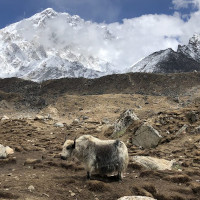
2 replies on “The Truth about Nepal, and Why Kaiser Permanente Sucks”
Oh my gosh, Terrill! What a crap ordeal! I’m glad you’re safe and you’ve got new insurance, because that’s unacceptable. Here’s to more safe & fun adventures in the future!
what a Nice Article thank you Very much for This Article.if you are looking for more fun and Safe Adventure Journey to Nepal Contact Us